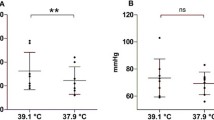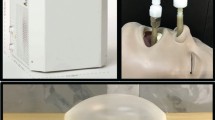Summary
In a series of 6 severely head injured patients, intraventricular as well as rectal, bladder and jugular vein temperature is recorded. The relationship between these temperatures in different conditions is evaluated. Intracerebral temperature is 0.5±0.2 °C (mean ± SD) higher than bladder temperature except in conditions such as brain death. It is concluded that rectal temperature is not representative and therefore not a good alternative to the measurement of brain temperature. More data on human intracerebral temperature are mandatory as well as prospective studies correlating intracerebral temperature with final outcome in head injury.
Similar content being viewed by others
References
Busto R, Dietrich W, Globus M, Valdes I, Scheinberg P, Ginsberg M (1987) Small differences in intrinsic brain temperature critically determine the extent of ischemic neuronal injury. J Cereb Blood Flow Metab 7: 719–738
Clifton G, Allen S, Berry J, Koch S (1992) Systemic hypothermia in treatment of brain injury. J Neurotrauma 9 [Suppl 2]: S487-S495
Chopp M, Welch K, Tidwell C, Knight R, Helpern J (1988) Effect of mild hyperthermia on recovery of metabolic function after global cerebral ischemia in cats. Stroke 19: 1521–1525
Dietrich W (1992) The importance of brain temperature in cerebral injury. J Neurotrauma 9 [Suppl]: S475-S485
Jiang J, Lyeth B, Clifton G, Jenkins L, Hamm R, Hayes R (1991) Relationship between body and brain temperature in traumatically brain-injured rodents. J Neurosurg 74: 492–496
Leonov Y, Sterz F, Safar P, Radovsky A, Oku K, Tisherman S, Stezoski W (1990) Mild cerebral hypothermia during and after cardiac arrest improves neurologic outcome in dogs. J Cereb Blood Flow Metab 10: 57–70
Lougheed W, Sweet W, White J, Brewster W (1955) The use of hypothermia in surgical treatment of cerebral vascular lesions. A preliminary report. J Neurosurg 12: 240–255
Martinez-Arizala A, Green B (1992) Hypothermia in spinal cord injury. J Neurotrauma 9 [Suppl 2]: S497-S505
Mellergård P (1992) Changes in human intracerebral temperature in response to different methods of brain cooling. Neurosurgery 31: 671–677
Mellergård P, Nordström C (1990) Epidural temperature and possible intracerebral temperature gradients in man. Br J Neurosurg 4: 31–38
Mellergård P, Nordström C (1991) Intracerebral temperature in neurosurgical patients. Neurosurgery 28: 709–713
Mellergård P, Nordström C, Christensson M (1990) A method of monitoring intracerebral temperature in neurosurgical patients. Neurosurgery 27: 654–657
Minamisawa H, Nordström C, Smith M, Siesjö B (1990) The influence of mild body and brain hypothermia on ischemic brain damage. J Cereb Blood Flow Metab 10: 365–374
Persson L, Hillered L (1992) Chemical monitoring of neurosurgical intensive care patients using intracerebral microdialysis. J Neurosurg 76: 72–80
Spetzler R, Hadley M, Rigamonti D, Carter L, Raudzens P, Shedd S, Wilkinson E (1988) Aneurysms of the basilar artery treated with circulatory arrest, hypothermia, and barbiturate cerebral protection. J Neurosurg 68: 868–879
Steen P, Milde J, Michenfelder J (1980) The detrimental effects of prolonged hypothermia and rewarming in the dog. Anesthesiology 52: 224–230
Sternau L, Thompson C, Dietrich WD, Busto R, Globus Y-T, Ginsberg MD (1991) Intracranial temperature — observations in the human brain. J Cereb Blood Flow Metab 11 [Suppl]: S123
Sundbårg G, Nordström C, Söderström S (1988) Complications due to prolonged ventricular fluid pressure recording. Br J Neurosurg 2: 485–495
Verlooy J, Veeckmans G, Heytens L, Selosse P (1993) Simultaneous monitoring of intracranial pressure and brain temperature in neurosurgical patients
Welsh F, Sims R, Harris V (1990) Mild hypothermia prevents ischemic injury in gerbil hippocampus. J Cereb Blood Flow Metab 10: 557–563
Author information
Authors and Affiliations
Rights and permissions
About this article
Cite this article
Verlooy, J., Heytens, L., Veeckmans, G. et al. Intracerebral temperature monitoring in severely head injured patients. Acta neurochir 134, 76–78 (1995). https://doi.org/10.1007/BF01428508
Issue Date:
DOI: https://doi.org/10.1007/BF01428508




